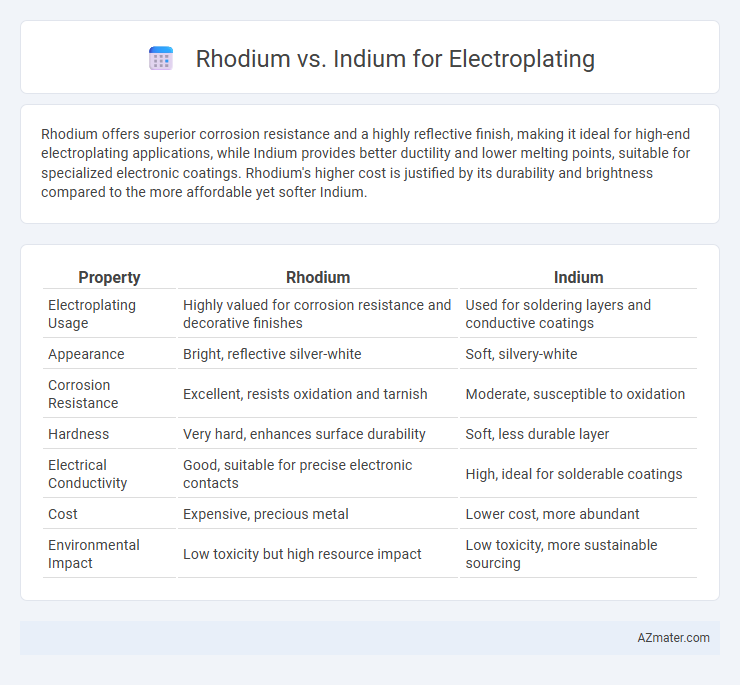Rhodium offers superior corrosion resistance and a highly reflective finish, making it ideal for high-end electroplating applications, while Indium provides better ductility and lower melting points, suitable for specialized electronic coatings. Rhodium's higher cost is justified by its durability and brightness compared to the more affordable yet softer Indium.
Table of Comparison
| Property | Rhodium | Indium |
|---|---|---|
| Electroplating Usage | Highly valued for corrosion resistance and decorative finishes | Used for soldering layers and conductive coatings |
| Appearance | Bright, reflective silver-white | Soft, silvery-white |
| Corrosion Resistance | Excellent, resists oxidation and tarnish | Moderate, susceptible to oxidation |
| Hardness | Very hard, enhances surface durability | Soft, less durable layer |
| Electrical Conductivity | Good, suitable for precise electronic contacts | High, ideal for solderable coatings |
| Cost | Expensive, precious metal | Lower cost, more abundant |
| Environmental Impact | Low toxicity but high resource impact | Low toxicity, more sustainable sourcing |
Introduction to Rhodium and Indium Electroplating
Rhodium electroplating provides a highly reflective, corrosion-resistant finish, commonly applied to jewelry, automotive parts, and electronics due to its hardness and inertness. Indium electroplating offers excellent adhesion and conductivity, making it ideal for semiconductor components, solder joints, and flexible electronics. Both metals require precise control of plating parameters to optimize coating thickness, uniformity, and durability for specialized industrial applications.
Chemical Properties and Composition
Rhodium, a member of the platinum group metals, exhibits exceptional corrosion resistance and high reflectivity due to its dense, hard crystalline structure, making it ideal for electroplating applications requiring durability and luster. Indium, a post-transition metal with a lower melting point and softness, offers superior adhesion and malleability but lacks the extreme hardness and chemical inertness of rhodium. Chemically, rhodium's resistance to oxidation and acids surpasses indium's relatively reactive nature, influencing the choice for protective and decorative coatings in harsh environments.
Electroplating Process Differences
Rhodium electroplating employs a cyanide-based electrolyte or non-cyanide alternatives, requiring precise control of current density and bath temperature to achieve a highly reflective, corrosion-resistant finish ideal for jewelry and electronics. Indium electroplating uses an acidic or neutral plating bath, often sulfate or chloride-based, with lower operating temperatures and a focus on achieving ductile, conductive coatings suitable for solderability and thermal management applications. The main process difference lies in the bath composition and operating conditions, where rhodium plating demands stricter control to prevent brittleness, whereas indium plating emphasizes maintaining bath stability for uniform, conductive layers.
Hardness and Wear Resistance
Rhodium offers superior hardness and exceptional wear resistance compared to indium, making it highly suitable for electroplating applications requiring durable and scratch-resistant coatings. Indium, being softer and more malleable, provides limited protection against abrasion but excels in forming conductive and corrosion-resistant layers. The hardness of rhodium, typically around 6 on the Mohs scale, significantly outperforms indium's approximate hardness of 1.2, ensuring enhanced longevity for plated surfaces.
Corrosion Resistance Capabilities
Rhodium exhibits superior corrosion resistance compared to indium, making it highly effective for electroplating applications exposed to harsh environments. Its dense, inert surface prevents oxidation and tarnishing, ensuring long-lasting protection on jewelry and automotive parts. Indium offers moderate corrosion resistance but is more prone to surface degradation under acidic or saline conditions.
Aesthetic Appeal and Surface Finish
Rhodium electroplating delivers a highly reflective, mirror-like finish with exceptional brightness and a brilliant white luster, making it ideal for jewelry and high-end decorative applications. Indium plating, while less common, provides a softer, more matte finish with excellent smoothness and corrosion resistance, suited for electronic components where subtle aesthetics blend with functionality. The choice between rhodium and indium plating depends significantly on the desired aesthetic appeal, with rhodium favored for striking brilliance and indium preferred for subtle surface uniformity.
Cost and Material Availability
Rhodium electroplating commands a significantly higher cost due to its rarity and limited global supply, often exceeding $10,000 per ounce, while Indium remains more affordable and widely accessible, priced around $500 per kilogram. The scarcity of Rhodium, predominantly mined as a byproduct of platinum and nickel ores, limits its availability for large-scale electroplating applications. Indium's more abundant deposits and stable supply chains make it a cost-effective alternative, especially in industries requiring consistent material sourcing.
Industrial and Commercial Applications
Rhodium offers superior corrosion resistance and hardness, making it ideal for high-wear industrial electroplating applications such as automotive parts and electrical contacts. Indium provides excellent conductivity and ductility, frequently used in commercial electronics and flexible display coatings where precise layer control is critical. Both metals enhance surface properties but are selected based on specific industrial needs, with rhodium preferred for durability and indium for electronic performance.
Environmental and Safety Considerations
Rhodium electroplating offers superior corrosion resistance and durability but involves toxic chemicals such as hexachloroplatinate, requiring stringent waste management and protective measures to minimize environmental impact. Indium plating uses less hazardous electrolytes, reducing operator exposure risks and environmental toxicity, though it lacks the extreme hardness and wear resistance of rhodium coatings. Both processes demand careful control of effluents and adherence to safety protocols to prevent contamination and ensure workplace safety during plating operations.
Choosing the Right Metal for Your Project
Rhodium offers superior corrosion resistance and a brilliant, durable finish ideal for high-wear applications and jewelry electroplating, while Indium provides excellent solderability and electrical conductivity, making it suitable for electronic components and specialized coatings. Cost considerations favor Indium due to its lower market price, but Rhodium's higher hardness and tarnish resistance justify its premium for luxury or demanding industrial uses. Evaluating project requirements such as durability, conductivity, appearance, and budget is essential to select the optimal metal for electroplating.

Infographic: Rhodium vs Indium for Electroplating
 azmater.com
azmater.com